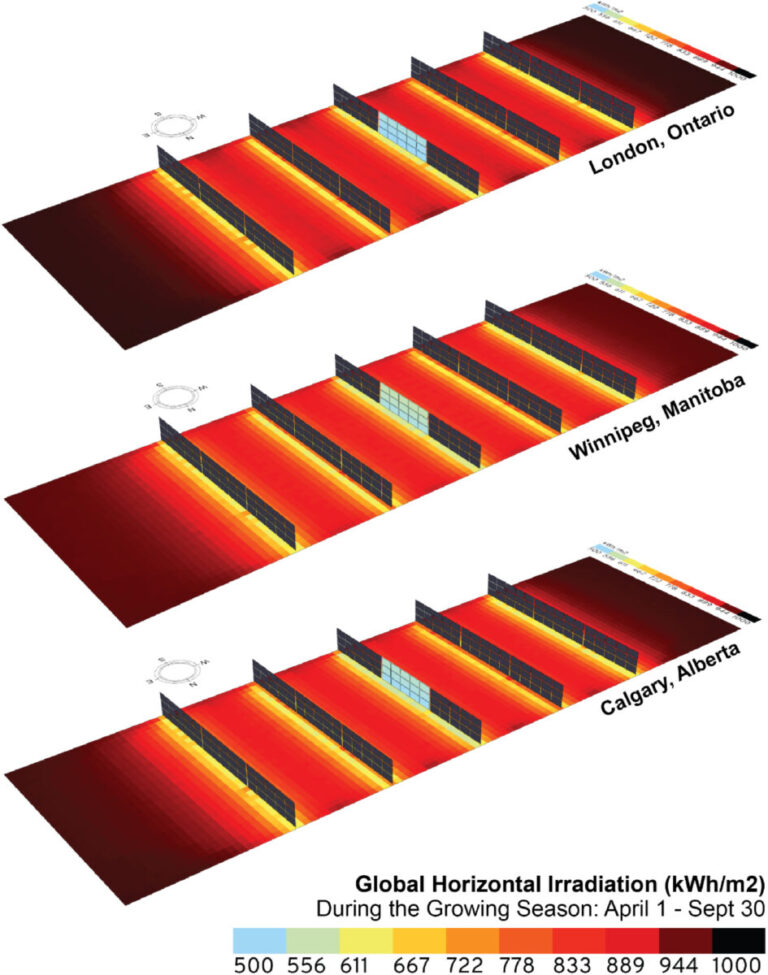Research at three Canadian sites sought to identify which crops can grow between differently spaced rows of vertical agrivoltaic systems. The scientists concluded that all traditional grains could be grown at the study sites, including arugula, beets, bok choy, celery, coriander, kale, broad beans, kale, lettuce, parsley, parsnips, peas, chard and thyme.
A group of researchers led by the University of Western Ontario in Canada has investigated which types of crops are better suited to being grown in vertical farming installations.
“This study examined the potential production of electrical energy for PV arrays and the solar radiation reaching the ground at three different distances and at three different Canadian agricultural locations – London, Calgary and Winnipeg – using radiation modeling,” said corresponding author Uzair Jamil . PV magazine.
The team conducted the experiments on three vertical, two-sided, east-west oriented agrivoltaic systems with an azimuth of 90 degrees to maximize power output. The arrays were installed 0.5 m above the ground with a height of 3.06 m. Their length was 2.05 m and their width 1.13 m. In the 3D model they were divided into rows with three arrays of 15 modules in each row section.
Climate data representing typical meteorological months was created, and the program simulated Canada’s main growing season, April 1 to September 30. In addition to the average irradiation, the cumulative radiation for each location and the cumulative irradiation during the growing season were also included in the calculation. the calculation.
According to the results, a distance of 45 meters in London left large areas unaffected by solar radiation values, but a slight reduction was recorded within 5-6 meters of the PV system. In the case of a distance of 15 m, within a distance of 2 meters from the panels, the irradiance values were approximately 150–170 W/m2 and continuously increased to 210 W/m2 above 4 meters. At a distance of 5 m, the ground radiation between the rows decreases to approximately 110–130 W/m2.
In Winnipeg the irradiance in the case of 5 meters was 110 W/m2, and in Calgary 110–130 W/m2. Regarding the distance of 15 m, the irradiation at both locations was a maximum of 210 W/m2. Also, large areas between the panels at a row distance of 45 m do not experience any reduction in sunlight in either case. As in all cases, the distance of 45 m had no major influence on the irradiation.
The scientists concluded that all of the area’s traditional grains could be grown at the agricultural voltaic sites, including arugula, beets, bok choy, celery, cilantro, kale, broad beans, kale, lettuce, parsley, parsnips, peas, chard and thyme. . They also emphasized that the 5-meter distance could have a negative impact on crops by not meeting their sunlight needs.
“Total electricity consumption in Canada in 2019 was approximately 632 TWh. The total electrical energy estimated from agrivoltaic energy use in just three provinces in Canada, as well as that of a handful of crops expected to perform well under agrivoltaic systems, amounts to 532 TWh,” they concluded. “This represents more than 84% of Canada’s total electricity needs and indicates a substantial potential increase in renewable energy generation in the country.”
Their findings were presented in “Solar energy modeling and proposed crops for different agrivoltaic systems,” published on Energy. The team also included academics from Colorado State University.
This content is copyrighted and may not be reused. If you would like to collaborate with us and reuse some of our content, please contact: editors@pv-magazine.com.


